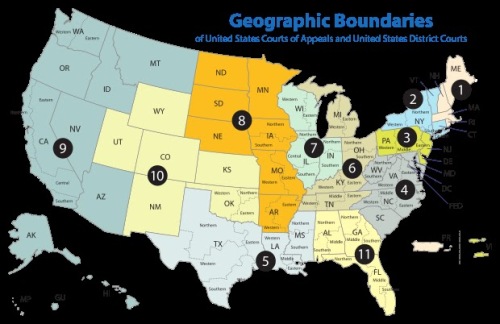
Judge Camille Velez-Rive has served as a U.S. Magistrate Judge for nearly two decades. As such, she can be considered a fairly uncontroversial selection for a federal judgeship.
Background
A Puerto Rico native, Camille Lizette Velez-Rive was born in San Juan on February 5, 1968. Velez-Rive received her B.A. from Washington University in St. Louis in 1989 and her J.D. from the University of Puerto Rico School of Law in 1993. After graduating, Velez-Rive clerked for Judge Francisco Rebollo Lopez of the Supreme Court of Puerto Rico. She then joined Pietrantoni Mendez & Alvarez in San Juan as an Associate. In 1998, she became a federal prosecutor with the U.S. Attorney’s Office for the District of Puerto Rico. She held that position until her appointment as a federal magistrate judge in 2004.
History of the Seat
Velez-Rive has been nominated for a vacancy on the U.S. District Court for the District of Puerto Rico. This seat opened when Judge Francisco Besosa moved to senior status on January 1, 2022.
Legal Experience
Velez-Rive started her legal career as a law clerk and then spent three years as an Associate in private practice. She then spent four years at the U.S. Attorney’s Office for the District of Puerto Rico, handling a wide variety of cases.
Notably, Velez-Rive handled a number of appellate matters before the First Circuit, defending the validity of convictions below. See, e.g., United States v. Hernandez-Albino, 177 F.3d 33 (1st Cir. 1999) (affirming conviction for conspiracy to possess cocaine); United States v. Rivera, 171 F.3d 37 (1st Cir. 1999) (affirming denial of motion for new trial); United States v. Morillo, 158 F.3d 18 (1st Cir. 1998) (reversing conviction for conspiracy for insufficiency of evidence); United States v. Hernandez, 146 F.3d 30 (1st Cir. 1998) (challenging sufficiency of evidence for conviction for felon in possession). She also helped brief challenges to suppression motions on appeals from the district court. See, e.g., United States v. Acosta-Colon, 157 F.3d 9 (1st Cir. 1998).
Velez-Rive later transitioned into handling civil cases, defending the federal government against claims brought under the Federal Tort Claims Act (FTCA). See, e.g., De Mangual v. United States, 131 F. Supp. 2d 263 (D.P.R. 2001). Notably, she successfully defended the federal government in a bench trial in a suit brought by a plaintiff who was injured by tripping on an uneven sidewalk. Sepulveda v. United States, 329 F. Supp. 2d 260 (D.P.R. 2004). She also, in that role, defended social security decisions. See, e.g., Cruz v. Barnhart, 265 F. Supp. 2d 173 (D.P.R. 2003); Chaparro v. Massanari, 190 F. Supp. 2d 260 (D.P.R. 2002).
Jurisprudence
Since 2004, Velez-Rive has served as a full-time U.S. Magistrate Judge with the U.S. District Court for the District of Puerto Rico. As a magistrate judge, Velez-Rive wrote reports and recommendations for substantive rulings, handled pleas and arraignments, and reviewed warrant applications.
Among the most notable cases in which she issued recommendations, Velez-Rive’s recommendation to dismiss a political discrimination case against the Mayor of San German was adopted as time-barred. See Llantin-Ballester v. Negron-Irizarry, 353 F. Supp. 2d 206 (D.P.R. 2005). By contrast, Velez-Rive denied motions to dismiss in another political discrimination case, finding that the case should move forward. Torres-Heredia v. Lopez-Pena, 708 F. Supp. 2d 148 (D.P.R. 2008).
On the criminal side, Velez-Rive recommended that a defendant’s motion for a Franks hearing should be denied for failure to offer sufficient factual support. See United States v. Perez Velasquez, 488 F. Supp. 2d 82 (D.P.R. 2006). In another case, Judge Aida Delgado-Colon concurred with Velez-Rive’s recommendation to deny a motion to suppress, finding that the defendant had been validly stopped based on reasonable suspicion. See United States v. Garcia-Robledo, 488 F. Supp. 2d 50 (D.P.R. 2007).
Velez-Rive’s rulings have generally been upheld on appeal. For example, the First Circuit upheld her grant of judgment on the pleadings to the Commonwealth of Puerto Rico in a constitutional claim involving a farmer’s tax credit program. See Perez-Acevedo v. Rivero-Cubano, 520 F.3d 26 (1st Cir. 2008).
Overall Assessment
Nominations to the District of Puerto Rico have rarely brought the same degree of partisan fervor as those to other courts. Judge Velez-Rive’s nomination is unlikely to be any different. Given her extensive experience as a federal magistrate judge, she will likely get bipartisan support.
